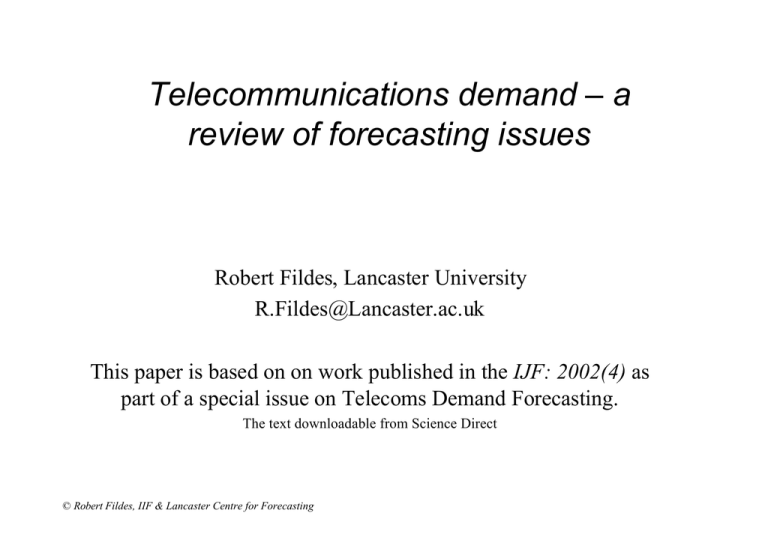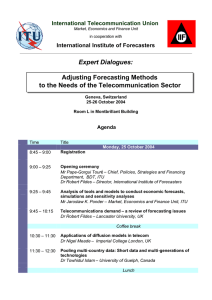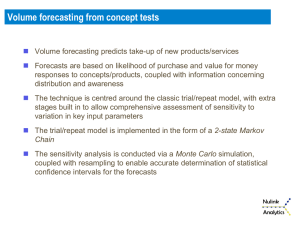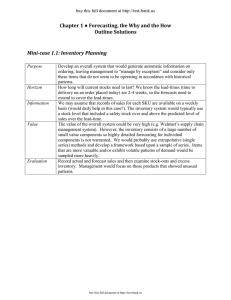Telecommunications demand – a review of forecasting issues
advertisement

Telecommunications demand – a review of forecasting issues Robert Fildes, Lancaster University R.Fildes@Lancaster.ac.uk This paper is based on on work published in the IJF: 2002(4) as part of a special issue on Telecoms Demand Forecasting. The text downloadable from Science Direct © Robert Fildes, IIF & Lancaster Centre for Forecasting Consumer End Uses •video • games • medical •home shopping via • internet • call centres (d) satellite (b) mobile Local carrier (a) PSDN IXC POT IXC Business End Uses (e) local bypass (c) Cable IXC2 © Robert Fildes, IIF & Lancaster Centre for Forecasting IXC2 • data transfer • video conferencing • group work • CAD/CAM •A Hierarchy of Forecasts Overall demand for an application Usage l Competition within technologies to service application l Access Competition between suppliers l l Once investment in place ä operating costs are minimal Equipment Forecasting Implications ä e.g. for entrants, price collusion, price leadership © Robert Fildes, IIF & Lancaster Centre for Forecasting Types of Telecommunications Forecasting Problems n Stable Markets - aggregate ä n Stable Markets - disaggregate ä n Public Switched Calling patterns Growth Markets ä Special Services • ä New services l ADSL Ø Corporate/ regulator data available Ø Surveys, customer behaviour Ø Ø Ø Ø Intentions Surveys Feature evaluations Trial markets Analogies – – other products other countries Ø Delphi/ Expert judgement Ø Statistical time series methods n Operations Different Differentproblems problems--different differentorganisational organisationalresponsibilities responsibilities © Robert Fildes, IIF & Lancaster Centre for Forecasting Stable Markets • Point-to-point PSTN – Local, long-distance, international • Drivers – Price, income, advertising, ‘value-for-money’ • Problem-specific drivers – Call-back on international • Price elasticity declining – Depends on price, culture US international message telephone service (IMTS): (Econometric comparisons, Madden et al, IJF) Econometric models with Focus on price elasticity estimation © Robert Fildes, IIF & Lancaster Centre for Forecasting Conclusions Conclusions -- Stable Stable Markets Markets n Increasing econometric sophistication Missing Missingout outor orincluding including model specification (externalities: market size) Ø diagnostics Ø multicollinearity - the interrelationship between the explanatory variables, Ø e.g ownership of durables and income •But no stability or forecasting tests •Time varying coefficients? © Robert Fildes, IIF & Lancaster Centre for Forecasting inappropriate inappropriatevariables variables êê •mis-understanding •mis-understandingthe themarket market ••poor poorforecasts, forecasts, •bad •badpolicy policy Does Doesthe themodel modelwork workbetter better than thanalternatives? alternatives? IsIsthe themarket marketchanging, changing, are arenew newservices servicesgetting gettingmore more acceptable, acceptable,isisquality qualitybecoming becoming more moreimportant? important? Stable Stable Markets Markets –– Disaggregate Disaggregate Access & Usage • Based on Cross-sectional household data • Conditional models of usage, given choice of technology or carrier • Focus on price elasticity – By household demographics to support universal service analysis – Linked to marketing planning Evaluation: Evaluation: Despite Despitetheir theiruse usefor forforecasting forecasting ••Dynamics Dynamicsof ofchange changenot nottaken takeninto intoaccount account ••No Noforecasting forecastingevaluation evaluation © Robert Fildes, IIF & Lancaster Centre for Forecasting New New Products Products && Services Services • Market Potential – mobile – ‘really new products’, e.g. 3G • Diffusion Path – E.g mobile • But now market dominated by ‘switchers’? © Robert Fildes, IIF & Lancaster Centre for Forecasting ØIntentions Surveys ØFeature evaluations ØChoice models ØTrial markets ØAnalogies – other products – other countries Market Potential for M1, Market Potential for first generation, M1 not M2 second generation, M2 Time line Adopters at T-1 Leavers Exit Switchers Adopters & Users at T Adopters at T Leavers Switchers Exit Adopters & Users at T+1 First generation Up to T Adopters & Users at T+1 Exit Forecasting telecommunication service subscribers in substitutive and competitive environments, Jun et al, IJF, 2002 © Robert Fildes, IIF & Lancaster Centre for Forecasting Both generations, Competition Competition Competition between between Technologies Technologies 160 140 1st Gen'ion 120 100 1st Gen'ion 80 2nd Gen'ion TOTAL 60 40 20 0 0 10 20 30 Period © Robert Fildes, IIF & Lancaster Centre for Forecasting 40 50 Market Market Potential Potential -Decomposition -Decomposition Methods Methods II (applies (appliesto tonew newand andestablished establishedmarkets markets Segmentation Approaches to Forecasting) All users Business Subscribers Business Personal Subscribers Professional Small Income > 30K Large Commercial Income < 30K Below 21 years Attending College Not attending 21 - 50 > 50 Income < 20K Not retired Income > 30K Retired Income <30K Large Service • Forecast consumption in each segment • Project numbers in each segment © Robert Fildes, IIF & Lancaster Centre for Forecasting }and multiply Decomposition Decomposition Methods Methods IIII Step: 1. Identify the most important services (in terms of load in bits per second on the network). 2. Segment the population, e.g business and consumer, high and low intensity users. 3. Using ideas of a time budget (the number of hours a day available for telecoms related use) estimate the services each segment might use, by service, and the level of usage. 4. Model the changes in the segments over time. 5. Obtain total traffic by aggregating the individual forecasts of the usage profiles. © Robert Fildes, IIF & Lancaster Centre for Forecasting Market Market Potential Potential -- Decomposition Decomposition Methods Methods III III Alternative Models of choice & Usage - for households with Internet Access (see Rappaport et al, 2001) Simultaneous Sequential ? ? PSDN ADSL ISDN2 PSDN Broadband? ADSL Usage models © Robert Fildes, IIF & Lancaster Centre for Forecasting ISDN2 Choice Choice Models Models -- segmenting segmenting consumers consumers and and forecasting forecasting each each segment segment Used in stable & growth markets n market research based ä ä observed data hypothetical questions for new products/ services Problems 6 sample size in small populations 6dynamics ä how do the parameters change over the planning horizon 6price ä ä dependency measurement (quality) projected behaviour © Robert Fildes, IIF & Lancaster Centre for Forecasting The The Bass Bass Model: Model: basic basic segmentation segmentation • Two types of people: – Innovators • They adopt because of their attitude to technology – Imitators • They adopt when exposed to consumers who have adopted already 20 Gompertz 18 16 14 12 10 8 6 Logistic 4 2 Red: Red:adopters adopters Black: Black:potential potentialadopters adopters Blue: Blue:lacking lackinginformation information © Robert Fildes, IIF & Lancaster Centre for Forecasting 57 53 49 45 41 37 33 29 25 21 17 13 9 5 1 0 Estimating the Diffusion Path: • limited if any sales data • S-Shaped curve used to represent adoptions • different curves and parameters Issues: Ø different market potential and uptake • data limitations trajectory Ø dependent on key parameters • market potential affected by product/ social factors The Effect of Increasing Imitation in the Social System The Effect of Increasing Innovation in the Social System 25 25 Households (millions) 15 Pulls curve leftwards 10 Households (Millions) 20 20 Increases Slope of the Curve 15 10 5 5 0 0 2000 2001 2002 2003 2004 2005 2006 2007 2008 2009 2010 2011 2012 2013 2014 2015 © Robert Fildes, IIF & Lancaster Centre for Forecasting 2000 2001 2002 2003 2004 2005 2006 2007 2008 2009 2010 2011 2012 2013 2014 2015 Modelling multinational telecommunications demand with limited data, Islam et al, IJF, 2002 The impact of networked groups (Bass defines a simple network) Models Models of of Interacting Interacting Individuals Individuals • Different networks of consumers Ø Different adoption patterns Connected to your two nearest neighbours Connected to near neighbours but with other links Connected at Random •Each •Eachgroup groupof ofindividuals individualshas hasits itsown ownrules rules of ofbehaviour behaviourand andinteraction interaction ••affected affectedby byits itsenvironment environment © Robert Fildes, IIF & Lancaster Centre for Forecasting How How can can these these ‘Agent ‘Agent based based models’ models’ be be used used (Collings, (Collings, BTExact) BTExact) • Aim to understand behaviour of interacting markets – Diverse individual behaviour – Asymmetric information and motivation • Examples – Financial markets – Customer relationship management © Robert Fildes, IIF & Lancaster Centre for Forecasting Diffusion models EXTENSIONS and ISSUES • Can include marketing and economic variables • Estimation (analogy or numerical methods) – Meta Models • link the diffusion parameters to market characteristics • to other products, other markets – Genetic algorithms • Incorporation of effects from other products/ markets • Supply restrictions (in regulated markets) • Disaggregate models ( e.g. to industry specific uptake of fax) © Robert Fildes, IIF & Lancaster Centre for Forecasting Bass Model - Diffusion Parameters and Meta Model Describing the speed and shape of the adoption path Mobile Average diffusion parameters Imitation NICs Japan UK, Denmark Innovation © Robert Fildes, IIF & Lancaster Centre for Forecasting Simulation Simulation Modelling Modelling ••system systemdynamics dynamicsreplicate replicatediffusion diffusioncurves curves ••offer offermore moreflexibility flexibilityfor forincorporating incorporating ––information informationand andprocesses processes ––decision decision variables variables Service provider Marketing influences Quality Price Understanding Utility Adoption Acceptability decision factors Potential Market Key benefit: transparency of model © Robert Fildes, IIF & Lancaster Centre for Forecasting Evaluation - Models of Market Potential • Choice Models – Based on intentions data Problems • ‘current intentions • changing valuations • Models of Market Penetration – define potential = CM(t) where M(t) is determined by the economic/ social system of the market – Based on analogous products and countries • unvalidated • c depends on time Evaluation - Models of the Diffusion Path • Aggregate Bass-type diffusion • Simulation © Robert Fildes, IIF & Lancaster Centre for Forecasting • Limited forecast validation – short term (if any) – use too much data – poor benchmarks • No forecast validation • Limited parameter validation Final Final comments comments • Widespread interest in telecoms forecasting • Survey evidence suggests organisations which adopt a more ambitious and rigorous approach do better • Primary methods ‘naïve qualitative’ – despite major investments (and disasters) riding on the results of a forecas – Structured use of judgement (E.g. Delphi: Knut Blind) • Too little academic research – too hard? – Too messy (Forecasting category sales and market share for wireless telephone subscribers: a combined approach, Kumar et al, IJF, 2004) IJF IJFSeminar Seminarobjectives: objectives: © Robert Fildes, IIF & Lancaster Centre for Forecasting ••identify identifywhere whereprogress progresshas hasbeen beenmade made ••‘gap’ ‘gap’analysis analysis








